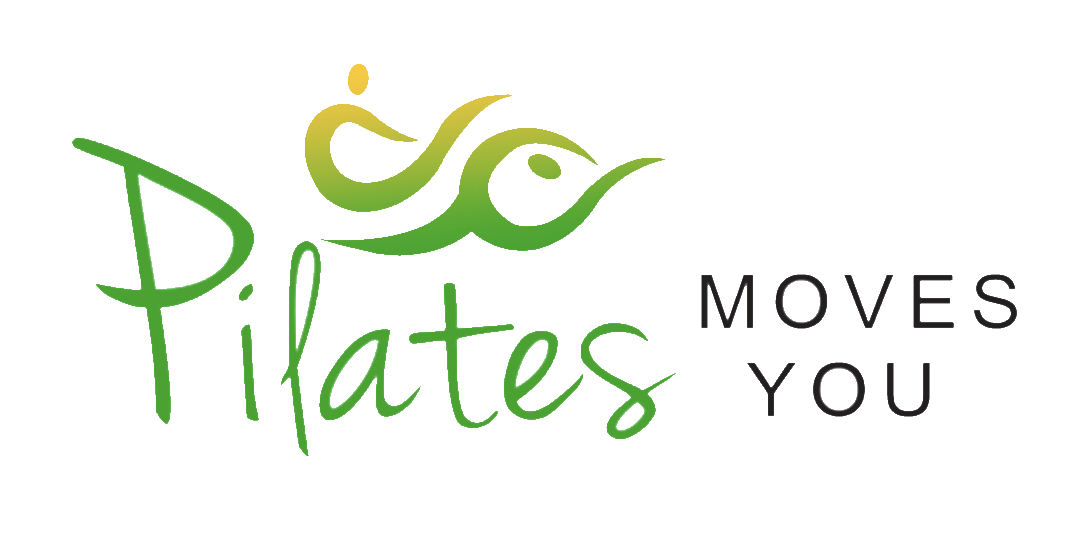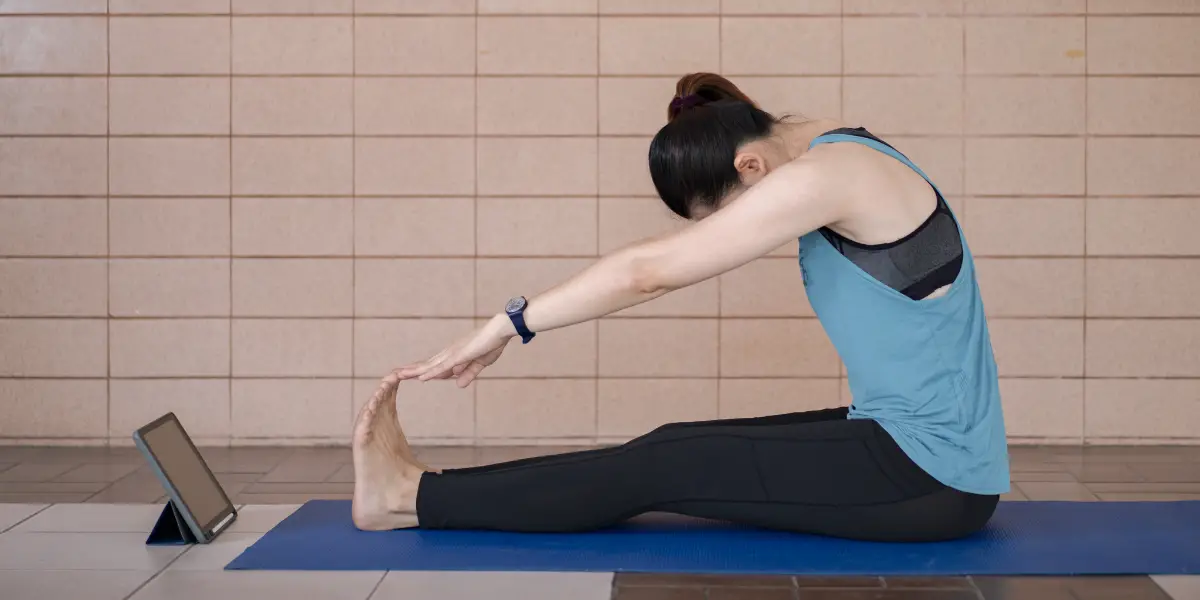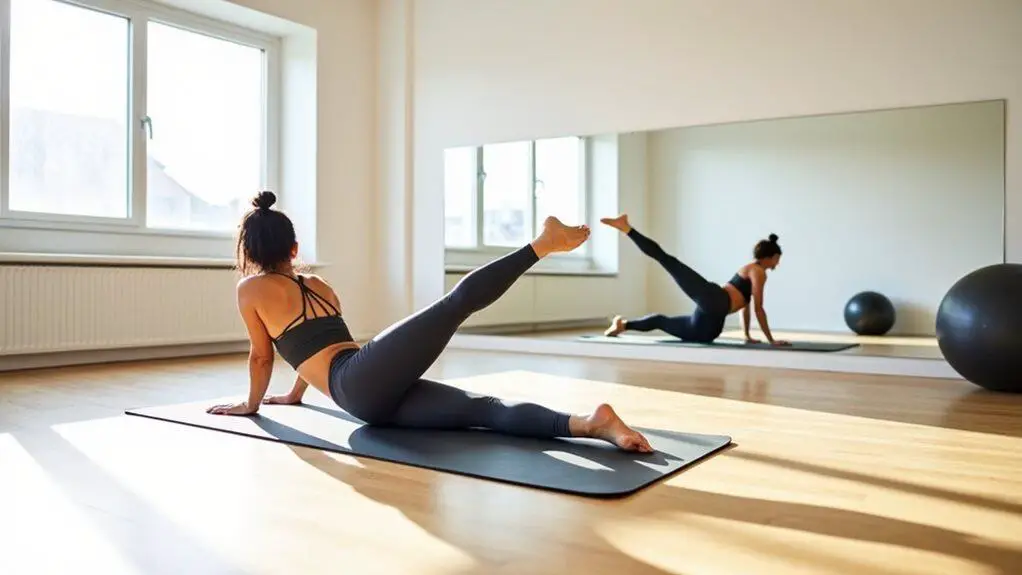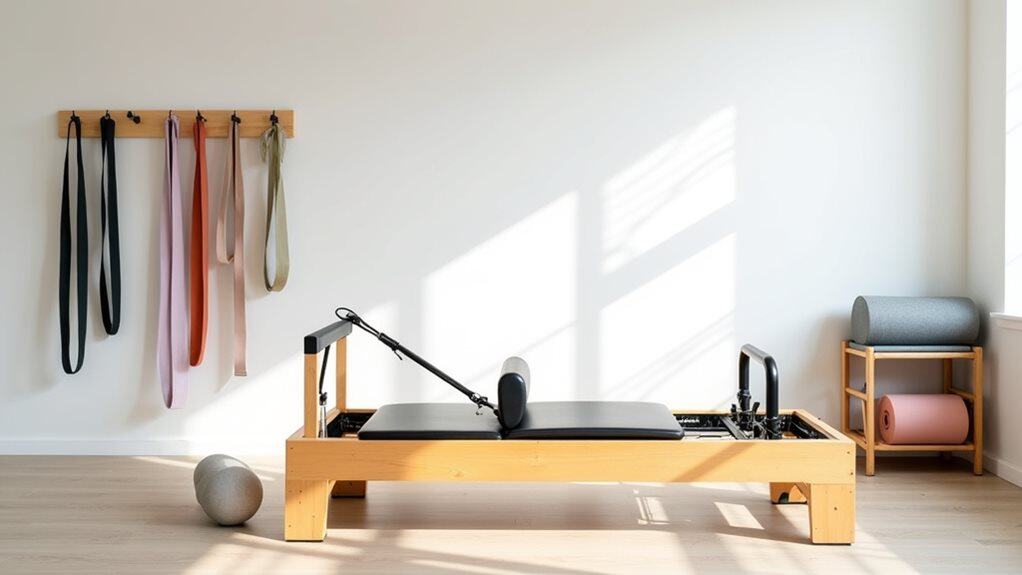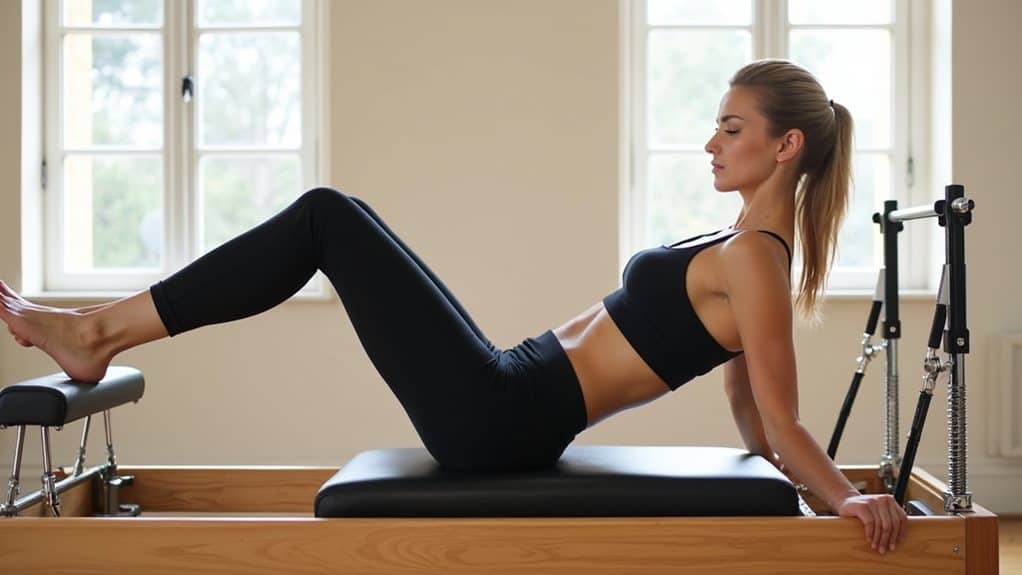If you’re like many people, the Pilates roll up is a bit of a struggle. Don’t worry, you’re not alone. Even the most seasoned Pilates pros need help with this classic exercise from time to time.
You can try several alternatives if you can’t do a Pilates roll up. These include scissor Pilates, plank variations, oblique crunches, spine stretch forward, single leg circle, and swan dive. Each exercise builds core strength and flexibility, eventually making it easier to perform the roll-up.
In this article, I’ll share some of my favorite alternatives to the Pilates roll up. So if you’re looking for new exercises, keep reading! I’m confident you’ll find some options that’ll help you improve your core strength and flexibility.
How To Properly Do a Pilates Roll Up
While the move can be challenging, it’s important to remember that this classic move is still a valuable part of a well-rounded Pilates practice. If you’re looking to master the Pilates roll up, here are some tips to help you do it properly:
Preparation
Before starting your Pilates roll up, preparing your body and mind is essential. Here are a few steps you can take to set yourself up for success:
- Warm up your muscles: Take a few minutes to do gentle stretches or light cardio to prepare your body for the exercise.
- Find a comfortable starting position: Lie on a mat with your arms extended overhead and your legs extended straight out in front of you. Make sure you have enough space around you to move freely.
- Focus your mind: Take a few deep breaths and clear your mind of distractions. Imagine yourself smoothly and effortlessly executing the Pilates roll up.
Execution
Now that you’re prepared, it’s time to start your Pilates roll up. Here are the steps to follow:
- Lift your head, neck, and shoulders off the ground, reaching your arms toward your toes.
- Engage your core muscles and lift your upper body off the ground, reaching your hands towards your feet.
- Slowly roll up, one vertebra at a time, until you are sitting upright with your legs bent and your feet flat on the ground.
- Inhale as you lift your arms towards the ceiling, and exhale as you slowly lower back down to the starting position.
Modifications and Variations
If you’re finding the Pilates roll up to be too demanding, there are a few modifications and variations you can try to make the exercise easier:
- Use a Pilates ball or foam roller to support you as you roll up.
- Start with bent knees and your feet flat on the ground, then slowly extend your legs as you build up your strength and flexibility.
- Work on alternative exercises, such as the scissor Pilates or the spine stretch forward, to help you build up the strength and flexibility you need for the Pilates roll up.
Remember to be patient and consistent with your practice, and you’ll eventually be able to master the Pilates roll up.
Understanding the Pilates Roll Up
Before diving into some alternative exercises to the Pilates roll up, let’s first take a moment to understand this classic move better. Specifically, you need to understand this exercise’s benefits and common mistakes.
Benefits of the Pilates Roll Up
The Pilates roll up offers several benefits, including:
- Improved core strength and stability
- Increased flexibility in the spine and hamstrings
- Better posture and balance
- Enhanced coordination and control
Common Mistakes To Avoid When Doing the Pilates Roll Up
As with any exercise, it’s essential to pay attention to form and technique when performing the Pilates roll up. Some common mistakes to avoid include the following:
- Lifting your head and shoulders too quickly or aggressively
- Allowing your legs to lift off the ground as you roll up
- Using momentum or swinging to help you raise your upper body
- Forgetting to exhale as you lift and inhale as you lower
Alternative Exercises for Building Core Strength
If you’re having trouble with the Pilates roll up, or if you just want to mix up your Pilates routine, plenty of alternative exercises can help you build up your core strength.
Here are a few options to try:
Scissor Pilates
Scissor Pilates is an excellent exercise for strengthening the abdominal muscles and improving core stability. To perform this exercise:
- Start by lying on a mat with your legs extended straight out in front of you.
- Lift your head, neck, and shoulders off the ground.
- Lift one leg off the ground, keeping it straight and pointing towards the ceiling.
- Bring the other leg up to meet the first leg, crossing them in a scissor-like motion.
- Alternate legs, keeping your lower back pushed firmly into the ground.
Plank Variations
Planks are a classic exercise for building core strength, and there are many variations you can try. Some options include:
- High plank: Start in a push-up position with your hands shoulder-width apart and your feet hip-width apart. Keep your body straight and your core engaged as you hold the position for 30 seconds or more.
- Side plank: Start in a plank position, but turn your body to one side, resting on your elbow and the outer edge of your foot. Lift your other arm towards the ceiling, and hold the position for 30 seconds or more.
- Plank jack: Start in a high plank position, with your hands shoulder-width apart and your feet hip-width apart. Jump your feet out to the sides and back in, keeping your core engaged and your body straight.
Oblique Crunches
Oblique crunches are an excellent way to target the muscles on the sides of your abdomen. To perform this exercise:
- Start by lying on a mat with bent knees and your feet flat on the ground.
- Place your hands behind your head.
- Lift your shoulders off the ground, engaging your core muscles.
- Bring your left elbow towards your right knee.
- Switch sides, bringing your right elbow towards your left knee.
- Continue alternating sides, keeping your core engaged and your lower back pressed firmly into the ground.
Alternative Exercises for Improving Flexibility
In addition to building core strength, flexibility is a crucial component of a well-rounded Pilates practice. If you’re looking to improve your flexibility, or if you just want to add some new exercises to your routine, try these alternatives to the Pilates roll up:
Spine Stretch Forward
The spine stretch forward is a fantastic exercise for increasing spinal and hamstring flexibility. To perform this exercise:
- Sit on a mat with your legs extended straight in front of you.
- Lean forward from the hips, reaching for your toes.
- Keep your back as straight as possible.
- You can use a strap or towel to help you reach further or hold onto your shins or ankles.
- Hold the stretch for a few deep breaths.
- Slowly sit back up.
Single Leg Circle
The single leg circle is a challenging exercise that helps to improve flexibility in the hips and lower back. To perform this exercise:
- Lie on a mat with your arms extended to the sides, and your legs extended straight toward the ceiling.
- Slowly lower one leg to the ground, keeping it straight and pointing towards the ceiling.
- Circle the leg out to the side, around and up over your head, and back down to the ground.
- Repeat the movement on the other side.
- Keep your core engaged, and your lower back against the ground as you perform the circle.
- Repeat the exercise for the desired number of repetitions on each side.
Swan Dive
The swan dive is perfect for increasing spine and upper body flexibility. Here’s how to perform this movement:
- Lie on your stomach on a mat with your arms extended overhead and your legs extended straight behind you.
- Lift your head, neck, and shoulders off the ground.
- Slowly lift your chest and arms off the ground as well.
- Reach your arms forward.
- Slowly lower back down to the ground.
- Repeat the movement for the desired number of repetitions.
- Keep your core engaged and your lower body pressed firmly into the ground as you perform the swan dive.
Incorporating Pilates Roll Up Alternatives into Your Workout
Now that you’ve learned about several alternative exercises to the Pilates roll up, you might wonder how to incorporate them into your workout routine.
Well, here are some tips to help you make the most of these exercises:
How Often to Practice
First, it’s crucial to find a balance when practicing these alternative exercises. On the one hand, it’s essential to challenge yourself and push yourself to improve. On the other, giving your body time to rest and recover is also necessary.
Here are a few general guidelines to follow:
- Beginner: 2-3 days per week, 1-2 days of alternatives.
- Intermediate: 3-4 days per week, 2-3 days of alternatives.
- Advanced: 4-5 days per week, 3-4 days of alternatives.
Remember, these are just general guidelines, and the right frequency will depend on your goals, needs, and fitness level.
Progression and Modifications
As you practice these alternative exercises, pay attention to your body and listening to what it needs. Here are a few things to keep in mind as you progress and modify your routine:
- Start with a manageable number of repetitions, and gradually increase as you build up your strength and endurance.
- Use modifications and variations to make the exercises easier or more challenging, depending on your needs.
- Pay attention to your form, and make sure you use the proper technique to avoid injury and get the most out of your practice.
Integrating Pilates Roll Up Alternatives into a Full Workout Routine
These alternative exercises work best when integrated into a well-rounded workout routine. Here are a few tips to help you do this:
- Vary your workouts: In addition to Pilates, consider incorporating other types of exercise such as cardio, strength training, and flexibility work.
- Mix it up: Instead of doing the same daily workouts, vary your routine and keep things interesting.
- Listen to your body: Pay attention to how you feel after each workout, and make adjustments to ensure you are getting the rest and recovery you need.
Tips for Success
The following tips will help you master the roll up if you’re committed to improving your Pilates skills. Here are some things to keep in mind:
Warm Up and Cool Down
Taking care of your body before and after your workouts is vital to help prevent injury and improve your performance.
- Warm up: Spend a few minutes stretching or doing some light cardio to get your body ready for your workout.
- Cool down: After your workout, take some time to stretch and relax your muscles to help them recover and prepare for your next workout.
Good Form Is Key
Proper technique is crucial for Pilates, especially when it comes to the roll up. Here are a few tips to help you maintain good form:
- Focus on your core: Keep your abdominal muscles engaged throughout the exercise to help support your spine and protect your lower back.
- Keep your movements smooth and controlled: Avoid jerky or uncontrolled movements, and focus on making each repetition as smooth and controlled as possible.
- Pay attention to your breath: Inhale as you lift, and exhale as you lower. This will help you stay focused and maintain good form.
Don’t Give Up!
Learning the Pilates roll up (or any new exercise) can be challenging, but staying patient and consistent with your practice is essential. Here are a few things to keep in mind as you work toward your goals:
- Celebrate your progress: Remember to celebrate your achievements, no matter how small they may seem.
- Be patient: It takes time and practice to master any new skill, so be patient with yourself and don’t get discouraged if you don’t see progress right away.
- Stay consistent: The key to success is consistency. Make sure to practice regularly, and you’ll eventually see progress.
Final Thoughts
I hope this article has given you some valuable insights into how to approach the Pilates roll up, and provided you with some practical alternatives to try in the meantime.
Remember that patience, consistency, and good form are crucial to success. With practice and dedication, you’ll be able to master the Pilates roll up and take your Pilates practice to the next level. So don’t give up, and keep working towards your goals!
Sources
- Very Well Fit: How to The Roll Up in Pilates
- Phi Pilates: Mastering the Pilates Roll Up
- Get Healthy U: How To Do Full Body Roll-Up
- Custom Pilates and Yoga: The Best Pilates Roll Up Modifications for Your Body
- Body Harmonics: Why can’t I do a Pilates rollup?
- Pilates Encyclopedia: How Do I Help Someone Who Struggles With The Roll Up?
